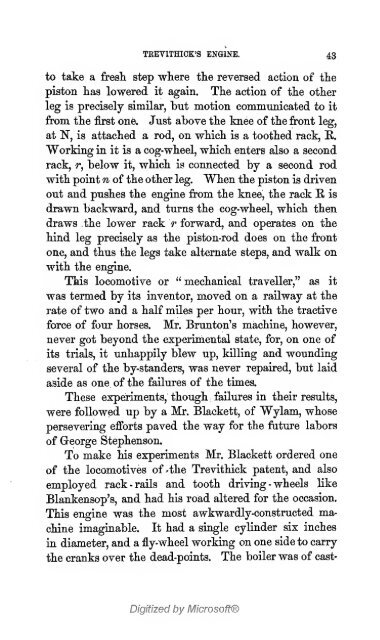The history of the first locomotives in America. From original ...
The history of the first locomotives in America. From original ...
The history of the first locomotives in America. From original ...
You also want an ePaper? Increase the reach of your titles
YUMPU automatically turns print PDFs into web optimized ePapers that Google loves.
TREVITHICK'S ENGINE. 43<br />
to take a fresh step wliere <strong>the</strong> reversed action <strong>of</strong> tlie<br />
piston lias lowered it aga<strong>in</strong>. <strong>The</strong> action <strong>of</strong> <strong>the</strong> o<strong>the</strong>r<br />
leg is precisely similar, hut motion communicated to it<br />
from <strong>the</strong> <strong>first</strong> one. Just above <strong>the</strong> knee <strong>of</strong> <strong>the</strong> front leg,<br />
at N, is attached a rod, on which is a too<strong>the</strong>d rack, R.<br />
Work<strong>in</strong>g <strong>in</strong> it is a cog-wheel, which enters also a second<br />
rack, r, helow it, which is connected by a second rod<br />
with po<strong>in</strong>t n <strong>of</strong> <strong>the</strong> o<strong>the</strong>r leg. "When <strong>the</strong> piston is driven<br />
out and pushes <strong>the</strong> eng<strong>in</strong>e from <strong>the</strong> knee, <strong>the</strong> rack E is<br />
drawn backward, and turns <strong>the</strong> cog-wheel, which <strong>the</strong>n<br />
draws <strong>the</strong> lower rack r forward, and operates on <strong>the</strong><br />
h<strong>in</strong>d leg precisely as <strong>the</strong> piston-rod does on <strong>the</strong> front<br />
one, and thus <strong>the</strong> legs take alternate steps, and walk on<br />
with <strong>the</strong> eng<strong>in</strong>e.<br />
This locomotive or " mechanical traveller," as it<br />
was termed by its <strong>in</strong>ventor, moved on a railway at <strong>the</strong><br />
rate <strong>of</strong> two and a half miles per hour, with <strong>the</strong> tractive<br />
force <strong>of</strong> four horses. Mr. Brunton's mach<strong>in</strong>e, however,<br />
never got beyond <strong>the</strong> experimental state, for, on one <strong>of</strong><br />
its trials, it unhappily blew up, kill<strong>in</strong>g and wound<strong>in</strong>g<br />
several <strong>of</strong> <strong>the</strong> by-standers, was never repaired, but laid<br />
aside as one, <strong>of</strong> <strong>the</strong> failures <strong>of</strong> <strong>the</strong> times.<br />
<strong>The</strong>se experiments, though failures <strong>in</strong> <strong>the</strong>ir results,<br />
were followed up by a Mr. Blackett, <strong>of</strong> Wylam, whose<br />
persever<strong>in</strong>g efforts paved <strong>the</strong> way for <strong>the</strong> fature labors<br />
<strong>of</strong> George Stephenson.<br />
To make his experiments Mr. Blackett ordered one<br />
<strong>of</strong> <strong>the</strong> <strong>locomotives</strong> <strong>of</strong> -<strong>the</strong> Trevithick patent, and also<br />
employed rack-rails and tooth driv<strong>in</strong>g-wheels like<br />
Blankensop's, and had his road altered for <strong>the</strong> occasion.<br />
This eng<strong>in</strong>e was <strong>the</strong> most awkwardly-constructed ma-<br />
ch<strong>in</strong>e imag<strong>in</strong>able. It had a s<strong>in</strong>gle cyl<strong>in</strong>der six <strong>in</strong>ches<br />
<strong>in</strong> diameter, and a fly-wheel work<strong>in</strong>g on one side to carry<br />
<strong>the</strong> cranks over <strong>the</strong> dead-po<strong>in</strong>ts. <strong>The</strong> boiler was <strong>of</strong> cast-<br />
Digitized by Micros<strong>of</strong>t®
















